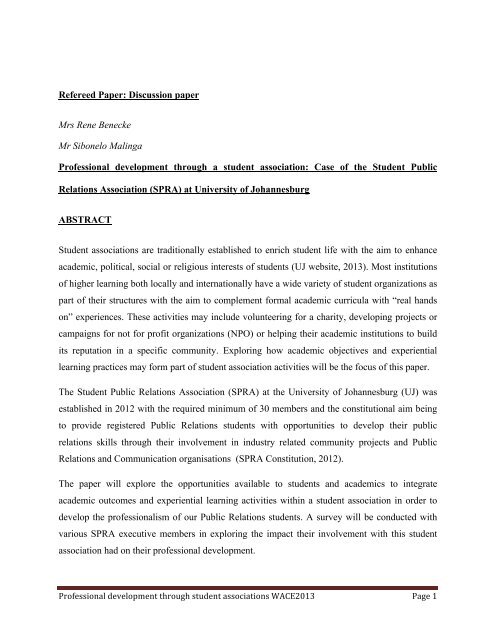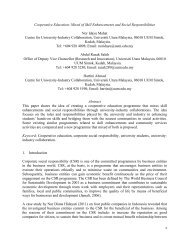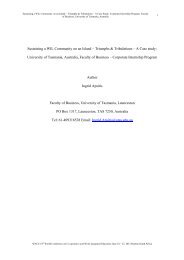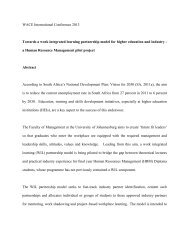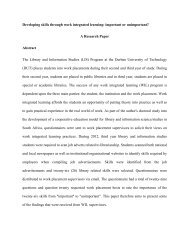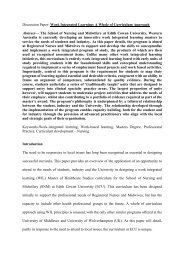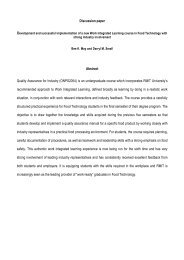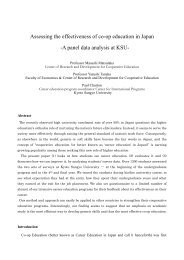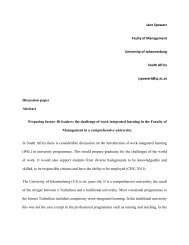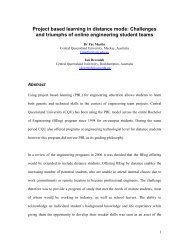Rene Benecke, University of Johannesburg (Discussion ... - WACE
Rene Benecke, University of Johannesburg (Discussion ... - WACE
Rene Benecke, University of Johannesburg (Discussion ... - WACE
You also want an ePaper? Increase the reach of your titles
YUMPU automatically turns print PDFs into web optimized ePapers that Google loves.
Refereed Paper: <strong>Discussion</strong> paper<br />
Mrs <strong>Rene</strong> <strong>Benecke</strong><br />
Mr Sibonelo Malinga<br />
Pr<strong>of</strong>essional development through a student association: Case <strong>of</strong> the Student Public<br />
Relations Association (SPRA) at <strong>University</strong> <strong>of</strong> <strong>Johannesburg</strong><br />
ABSTRACT<br />
Student associations are traditionally established to enrich student life with the aim to enhance<br />
academic, political, social or religious interests <strong>of</strong> students (UJ website, 2013). Most institutions<br />
<strong>of</strong> higher learning both locally and internationally have a wide variety <strong>of</strong> student organizations as<br />
part <strong>of</strong> their structures with the aim to complement formal academic curricula with “real hands<br />
on” experiences. These activities may include volunteering for a charity, developing projects or<br />
campaigns for not for pr<strong>of</strong>it organizations (NPO) or helping their academic institutions to build<br />
its reputation in a specific community. Exploring how academic objectives and experiential<br />
learning practices may form part <strong>of</strong> student association activities will be the focus <strong>of</strong> this paper.<br />
The Student Public Relations Association (SPRA) at the <strong>University</strong> <strong>of</strong> <strong>Johannesburg</strong> (UJ) was<br />
established in 2012 with the required minimum <strong>of</strong> 30 members and the constitutional aim being<br />
to provide registered Public Relations students with opportunities to develop their public<br />
relations skills through their involvement in industry related community projects and Public<br />
Relations and Communication organisations (SPRA Constitution, 2012).<br />
The paper will explore the opportunities available to students and academics to integrate<br />
academic outcomes and experiential learning activities within a student association in order to<br />
develop the pr<strong>of</strong>essionalism <strong>of</strong> our Public Relations students. A survey will be conducted with<br />
various SPRA executive members in exploring the impact their involvement with this student<br />
association had on their pr<strong>of</strong>essional development.<br />
Pr<strong>of</strong>essional development through student associations <strong>WACE</strong>2013 Page 1
1. Introduction<br />
One <strong>of</strong> the main objectives <strong>of</strong> all educational programmes and the focus <strong>of</strong> higher education<br />
institutions is to ensure that students who graduate are knowledgeable, competent and<br />
pr<strong>of</strong>essional. Add to this institutional objective, the students’ expectation <strong>of</strong> finding suitable and<br />
financially rewarding employment on graduating and you have the ingredients <strong>of</strong> a very complex<br />
and challenging state <strong>of</strong> affairs. In a recent address during an awards function for academic<br />
achievers, a young pr<strong>of</strong>essional and 2013 SPRA chairperson told the audience that in order to<br />
stand out from the crowd you need to work hard, complete what you have started and get<br />
involved. Being involved may mean different things to different people and the wide variety <strong>of</strong><br />
formal student associations at higher education institutions and their benefits may make the<br />
choice and level <strong>of</strong> involvement difficult.<br />
Student associations are traditionally established to enrich student life with the aim to enhance<br />
academic, political, social or religious interests <strong>of</strong> students (UJ website, 2013). Most institutions<br />
<strong>of</strong> higher learning both locally and internationally have a wide variety <strong>of</strong> student organizations as<br />
part <strong>of</strong> their structures. The aim is to complement formal academic curricula with “real hands<br />
on” experiences. These activities may include volunteering for a charity, developing projects or<br />
campaigns for not-for-pr<strong>of</strong>it organizations (NPO) or helping their academic institutions to build<br />
its reputation in a specific community. Benefits to members include networking opportunities,<br />
leadership development and social events.<br />
Pr<strong>of</strong>essional development through student associations <strong>WACE</strong>2013 Page 2
The reasons why students join as well as some <strong>of</strong> the challenges experienced by student<br />
associations influence their effectiveness and the value they add to the students’ overall learning<br />
and ultimately the pr<strong>of</strong>essional development <strong>of</strong> the individual. Understanding this in the context<br />
<strong>of</strong> a holistic approach to learning as the key objective <strong>of</strong> cooperative education, necessitates<br />
further investigation into the role that student associations may play in their pr<strong>of</strong>essional<br />
development.<br />
The aim <strong>of</strong> this paper is to explore how current student association activities are linked to<br />
academic objectives and experiential learning practices in order to develop knowledgeable,<br />
competent and pr<strong>of</strong>essional graduates.<br />
2. Student Associations<br />
Student associations form part <strong>of</strong> student life and are structures developed by students for<br />
students.<br />
The development <strong>of</strong> student associations is also rooted in the shared needs and<br />
interests <strong>of</strong> the students resulting in uniquely developed constitutions, membership pr<strong>of</strong>iles and<br />
activities. Membership may consist exclusively <strong>of</strong> students or in some cases an 80/20 percent<br />
split with some faculty or institutional representation (IUPUI website). Annual registration <strong>of</strong><br />
both the association and members is common practice at most institutions. Membership fees are<br />
generally very reasonable necessitating additional funds being generated though sponsors or<br />
fundraising events.<br />
Different types <strong>of</strong> student associations include social, academic or religious interests and the<br />
activities are in line with the pr<strong>of</strong>ile <strong>of</strong> the association. For the purpose <strong>of</strong> this paper the focus<br />
will be on the development <strong>of</strong> an academic student association in the Public Relations<br />
Pr<strong>of</strong>essional development through student associations <strong>WACE</strong>2013 Page 3
programme at UJ. Academic student associations pride themselves in organising events which<br />
will enhance the academic development <strong>of</strong> its members and will include guest speakers, student<br />
conferences and community outreach events.<br />
3. Developing pr<strong>of</strong>essional public relations students<br />
The terms pr<strong>of</strong>essionalism, pr<strong>of</strong>ession and pr<strong>of</strong>essional development are <strong>of</strong>ten used<br />
interchangeably and without a shared understanding <strong>of</strong> what is meant with these terms (Swick,<br />
2000). In Public Relations specifically there has been numerous debates around criteria and<br />
practices associated with pr<strong>of</strong>essionalism (Theaker and Yaxley, 2013:42). Notwithstanding the<br />
uncertainty regarding an all-inclusive definition <strong>of</strong> pr<strong>of</strong>essionalism the importance <strong>of</strong><br />
pr<strong>of</strong>essional practice is not disputed but rather promoted.<br />
For the purpose <strong>of</strong> this paper<br />
pr<strong>of</strong>essionalism is understood to include behaviour that demonstrates formal education and<br />
experience, practiced according to accepted standards by members <strong>of</strong> a specific pr<strong>of</strong>ession. The<br />
general opinion is that pr<strong>of</strong>essionalism must be taught and assessed and not assumed to exist as<br />
an inherent quality. Pr<strong>of</strong>essionalism is also influenced by time and context (Wilkinson, Wade<br />
and Knock, 2009).<br />
This approach to pr<strong>of</strong>essionalism implies aspects such as personal<br />
accountability, lifelong learning and pr<strong>of</strong>essional development.<br />
Pr<strong>of</strong>essional development can be defined as the acquiring <strong>of</strong> relevant knowledge, skills, and<br />
personal development in a specific industry on a continuous basis to ensure relevant and<br />
contemporary globally acceptable practices (Theaker and Yaxley, 2013). Pr<strong>of</strong>essional<br />
development further implies an involvement with formal structures such as a recognized<br />
pr<strong>of</strong>essional body which may <strong>of</strong>fer Continuous Pr<strong>of</strong>essional Development (CPD) opportunities<br />
as well as the standards <strong>of</strong> practice. These standards <strong>of</strong> practice are available online and in<br />
Pr<strong>of</strong>essional development through student associations <strong>WACE</strong>2013 Page 4
various text books to all public relations scholars and should be studied in order for the<br />
practitioners to apply them to their own unique contexts.<br />
4. Integrating student association objectives with formal learning objectives<br />
Integrating various experiences <strong>of</strong> a student such as those found in formal classroom settings as<br />
well as informal experiences forms part <strong>of</strong> active learning and learning by doing promulgated in<br />
experiential learning theory. Experiential learning is a holistic approach to learning. It<br />
acknowledges the importance <strong>of</strong> learning through action and reflecting on experiences in order to<br />
change informal experiences into formal learning opportunities (<strong>Benecke</strong> and Bezuidenhout,<br />
2011). Students involve themselves in academic student association activities such as listening to<br />
a guest speaker from industry or attending a conference in order to develop their own knowledge<br />
and to experience aspects <strong>of</strong> their future careers. In the case <strong>of</strong> Public Relations, involvement in<br />
student association activities may also afford students the opportunity to practice their event<br />
organising, stakeholder engagement and relationship building skills, making student association<br />
membership an attractive and entertaining option to achieve some <strong>of</strong> the experience needed to<br />
ensure employability. Ensuring that these experiences develop into formal experiential learning<br />
activities require planning, assessment and structure typical to all cooperative learning<br />
programmes. These requirements may present the student association and the faculty with a<br />
number <strong>of</strong> challenges.<br />
Research done on factors motivating students to join student associations highlighted some<br />
challenges and issues such as time, perceived value or benefits and perceived pr<strong>of</strong>essionalism <strong>of</strong><br />
the association (Hegedus and Knight, 2002).<br />
Pr<strong>of</strong>essional development through student associations <strong>WACE</strong>2013 Page 5
The issues <strong>of</strong> time and sustainability relate to the fact that students <strong>of</strong>ten find it difficult to<br />
involve themselves in the activities <strong>of</strong> student associations due to their academic commitments,<br />
work responsibilities and personal lives. Many students also commute by means <strong>of</strong> public<br />
transport which affects the time and opportunities to be involved with such activities.<br />
The perceived value that membership may <strong>of</strong>fer to students will depend on how well the<br />
objectives <strong>of</strong> the association correspond with the students’ perception <strong>of</strong> their future careers and<br />
how it will assist them in developing further skills for the working environment (Wei and<br />
Zhonghang, 2010; Hegedus and Knight, 2002). It was a general finding in the studies conducted<br />
that students do think that membership and active involvement with a student association will aid<br />
them in developing various skills, especially in leadership. This was also supported in an<br />
exploratory group interview with leaders <strong>of</strong> the Student Public Relations Association at<br />
<strong>University</strong> <strong>of</strong> <strong>Johannesburg</strong> (UJ).<br />
The perceived value and benefits that membership and involvement with the student association<br />
<strong>of</strong>fers is also linked to the level <strong>of</strong> pr<strong>of</strong>essionalism that the association displays. There seems to<br />
be a concern amongst the students that the level <strong>of</strong> pr<strong>of</strong>essionalism <strong>of</strong> student associations needs<br />
to be improved (Hegedus and Knight, 2002). This perception influences their willingness to join<br />
and influence the reputation amongst external stakeholders <strong>of</strong> the value and contribution that<br />
membership may <strong>of</strong>fer students.<br />
From the faculty perspective, challenges include sustainability and continuity due to the fact that<br />
students spend a relatively short period at the institution. There is constant change in the<br />
membership and leadership <strong>of</strong> the student association, which complicates the integration <strong>of</strong><br />
activities as credit bearing learning outcomes. In order to be a credit bearing component in the<br />
Pr<strong>of</strong>essional development through student associations <strong>WACE</strong>2013 Page 6
curricula <strong>of</strong> programmes assessments need to be planned and formally conducted, ideally<br />
according to scaffolding learning principles. This requirement needs close coordination between<br />
faculty members and the student association leadership. This is difficult if a student association<br />
is strictly independent from any permanent institutional structures other than student governance.<br />
Current governing structures at UJ (UJ website, 2013) stipulate that student associations need to<br />
be independent <strong>of</strong> faculty structures. Annual association and membership renewal <strong>of</strong>ten result in<br />
members only becoming active and available for projects later on in the academic year. This<br />
limits the activities <strong>of</strong> the student association as well as possible integration <strong>of</strong> formal learning<br />
outcomes set by the curriculum and faculty.<br />
5. Background to the Student Public Relations Association (SPRA)<br />
Establishing a student association starts with a shared vision <strong>of</strong> like-minded individuals such as a<br />
group <strong>of</strong> senior public relations students. This highly motivated group <strong>of</strong> students wanted to<br />
address the needs <strong>of</strong> students to improve their academic results, develop a better understanding<br />
<strong>of</strong> the public relations industry, gain experience and establish networks. These would then assist<br />
them in finding work integrated learning placements during their final year and future positions<br />
in a very competitive market.<br />
Negotiations with the formal UJ student governing structures were started by one <strong>of</strong> the founder<br />
members and 2011 chairperson, who had strong Student Representative Council affiliations. By<br />
April 2012 the constitution was in place. A membership recruitment drive resulted in the<br />
required minimum <strong>of</strong> 30 members joining and establishing SPRA as a formally recognized<br />
academic student association <strong>of</strong> the <strong>University</strong> <strong>of</strong> <strong>Johannesburg</strong> (UJ). An executive team <strong>of</strong> 11<br />
members was appointed with ex-<strong>of</strong>ficio status granted to the curriculum chair <strong>of</strong> the Diploma in<br />
Public Relations and Communication and a lecturer in the Department <strong>of</strong> Strategic<br />
Pr<strong>of</strong>essional development through student associations <strong>WACE</strong>2013 Page 7
Communication. Weekly meetings were conducted by the executive team and once a month<br />
with the members. Within the first two months <strong>of</strong> launching SPRA, members planned and held<br />
two community outreach projects, namely, Career Fair at Alexandra Township and Mandela Day<br />
at Helen Joseph Hospital, Auckland Park, <strong>Johannesburg</strong>. Both events were executed in<br />
partnership with internal UJ structures and external organizations.<br />
Membership grew consistently. By the time <strong>of</strong> the all important Student Conference in October<br />
2012, membership increased to more than 70 active members. The Student Conference was<br />
organized in conjunction with the pr<strong>of</strong>essional body, Public Relations Institute <strong>of</strong> Southern<br />
Africa (PRISA) who assisted with key note speakers and sponsorship.<br />
The executive team needed support on various levels such as resources i.e. a boardroom for<br />
meetings and telephones; assistance with institutional procurement practices; industry contacts<br />
for sponsorships; and media relations. Social media platforms were used to promote SPRA, to<br />
ensure an online presence and contact with members via their preferred means <strong>of</strong><br />
communication. Active involvement by faculty members as ex-<strong>of</strong>ficio members <strong>of</strong> the SPRA<br />
provided support and guidance to the executive team. Most <strong>of</strong> the student executive team were<br />
completing their work integrated learning module (WIL) during this time resulting in meetings<br />
and activities taking place after <strong>of</strong>fice hours. Faculty members attended weekly executive<br />
meetings as well as the launch function and Student Conference 2012.<br />
In line with institutional guidelines requiring annual registration <strong>of</strong> the association and members<br />
and due to the fact that all the executive team members had graduated, a new executive team had<br />
to be elected. The 2012 executive team selected the new leadership by shortlisting members who<br />
were actively involved in the association during 2012. They were interviewed to determine their<br />
Pr<strong>of</strong>essional development through student associations <strong>WACE</strong>2013 Page 8
leadership skills and to match the various portfolios with the candidates. The ten (10) member<br />
new executive team was announced in December 2012 and orientation done in January 2013.<br />
The 2012 team played a role in orientating the new executive team but some support functions<br />
still needed to be done by the faculty members. The 2013 executive team embarked on a major<br />
membership drive and by mid-March had recruited 180 members. Various partnerships have<br />
also been developed between SPRA and internal departments such as Alumni and Corporate<br />
Communication. A number <strong>of</strong> activities are planned for the year which will include several <strong>of</strong> the<br />
2012 projects but also a few new ones.<br />
As an academic student association it was important to review the academic development <strong>of</strong> the<br />
members. The Student Conference in October 2012 hosted a wide variety <strong>of</strong> topics. Industry<br />
speakers aimed to develop a better understanding amongst students <strong>of</strong> the current practices in the<br />
public relations and communication industry. 110 delegates attended the event which was open<br />
to students from UJ and other local institutions. As the conference was organized by the students<br />
it provided the executive team the opportunity to practice their event management skills, their<br />
media writing and relationship management skills.<br />
As mentioned before, many <strong>of</strong> the executive team was in their final year <strong>of</strong> studying towards<br />
their Diploma in Public Relations and Communication. Based on their involvement as SPRA<br />
executive members, some students used the different activities for their work integrated learning<br />
portfolio <strong>of</strong> evidence. The portfolio <strong>of</strong> evidence is used to assess learning outcomes for the WIL<br />
module which students register for as a credit bearing component.<br />
Exploratory group interviews with three executive members <strong>of</strong> SPRA clearly indicated that a<br />
wide variety <strong>of</strong> skills have been developed or existing skills enhanced. All the respondents<br />
Pr<strong>of</strong>essional development through student associations <strong>WACE</strong>2013 Page 9
shared the view that their involvement with SPRA and especially the leadership <strong>of</strong> this student<br />
association had enabled them to be better communicators, interacting more effectively with<br />
diverse individuals and groups, plan and implement various activities, write better and present<br />
their work with more confidence. They all indicated that the opportunity to “practice”<br />
stakeholder engagement and interpret public relations theory reinforced their knowledge or gave<br />
them the opportunity to change their approach. Affirmation and approval <strong>of</strong> specific approaches<br />
to problems and engagements acted as a confidence booster to the individuals, confirming that<br />
they can cope with future demands in similar contexts for example a working environment.<br />
These comments indicated reflective learning and support learning cycles as seen in experiential<br />
learning theory (Kolb, 1984).<br />
6. Recommendations and further research opportunities<br />
Developing pr<strong>of</strong>essionalism through student associations requires the integration <strong>of</strong> activities by<br />
the association, the academic programme or curriculum, faculty and institution together with the<br />
pr<strong>of</strong>essional body representing the relevant industry. In the case <strong>of</strong> an academic student<br />
association it is essential to ensure that formal learning outcomes are formulated, in collaboration<br />
with the specific programme students are registered for. These activities are assessed and credit<br />
bearing. A wide variety <strong>of</strong> assessment methods may be used in pr<strong>of</strong>essional development as<br />
suggested by Wilkinson, Wade and Knock (2009) in their study involving healthcare<br />
pr<strong>of</strong>essionals. These assessment methods are very similar to those used in academic and applied<br />
programmes and include observational and reflective reports, client feedback, self assessments<br />
and group evaluations. Evaluating the achievements <strong>of</strong> student associations will assist in gaining<br />
the necessary reputation and pr<strong>of</strong>essional status required to recruit members and secure the<br />
support from faculty members and industry representatives.<br />
Pr<strong>of</strong>essional development through student associations <strong>WACE</strong>2013 Page 10
Support and enabling structures are essential to the success <strong>of</strong> a student association. Due to the<br />
temporary nature <strong>of</strong> its membership these associations cannot function entirely independently<br />
from faculty. Students need to understand that the various activities both in class and organized<br />
by the student association form an integral part <strong>of</strong> their learning. It also gives them an<br />
opportunity to gain experience in the relevant industry they are preparing for. This aspect links<br />
closely with the key principles <strong>of</strong> experiential learning and cooperative education.<br />
Developing leadership skills has been cited by many as one <strong>of</strong> the key benefits <strong>of</strong> student<br />
association membership. Student associations and the various executive leaders are important<br />
role players in ensuring that the faculty and curriculum developers are in touch with the needs<br />
and developments <strong>of</strong> their students. It allows for establishing long term relationships with<br />
academia and future student association leadership.<br />
A closer link between the various structures and the activities will not only consolidate and<br />
integrate these but will also enable students, faculty and industry to achieve better results and<br />
will benefit the student association members.<br />
The industry will benefit in that the<br />
pr<strong>of</strong>essionalism <strong>of</strong> future practitioners will be developed and faculty will benefit in this holistic<br />
approach to learning.<br />
Further research is necessary to determine the value <strong>of</strong> these practices and the most effective<br />
types <strong>of</strong> activities academic student associations should include in their annual calendar.<br />
7. Conclusion<br />
Achieving pr<strong>of</strong>essionalism through student association membership is a challenge. It needs the<br />
combined attention <strong>of</strong> student association leadership, faculty members, institutional support<br />
structures and industry partners. These are similar requirements in successful cooperative<br />
Pr<strong>of</strong>essional development through student associations <strong>WACE</strong>2013 Page 11
education programmers and for this reason an organization such as the World Association <strong>of</strong><br />
Cooperative Education <strong>of</strong>fers a suitable platform for further developments in this area.<br />
8. References<br />
<strong>Benecke</strong>, D. R and Bezuidenhout, R. 2011. Experiential learning in public relations education in<br />
South Africa. Journal <strong>of</strong> Communication Management. Vol 15 (1). P55-70<br />
Hegedus, Christine M, and<br />
Knight James. 2002. Student Participation in Collegiate<br />
Organizations – Expanding the Boundaries. Retrieved March 11, 2013.<br />
(http://www.leadershipeducators.org/Resources/Documents/Conferences/<br />
Lexington/Hegedus.pdf)<br />
Kolb, D.A. 1984. Experiential learning: Experience as the source <strong>of</strong> learning and development.<br />
Prentice-Hall, Inc. New Jersey.<br />
Lizzio, A., Wilson, K., and Simons R. 2002. <strong>University</strong> students’ perceptions <strong>of</strong> the learning<br />
environment and academic outcomes: implications for theory and practice. Studies in Higher<br />
Education 27(1):27-52.<br />
Theaker , A and Yaxley, H. 2013. The Public Relations Strategic Toolkit. Abingdon, Oxon:<br />
Routledge.<br />
Wei, L. and Zhonghang, B. 2010. The analysis <strong>of</strong> the impact <strong>of</strong> college student organization on<br />
the overall quality <strong>of</strong> the college students. Vol. 2: 295 – 298.<br />
Pr<strong>of</strong>essional development through student associations <strong>WACE</strong>2013 Page 12
Wilkinson, TJ., Wade, WB. and Knock, LD. 2009. A Blueprint to Assess Pr<strong>of</strong>essionalism:<br />
Results <strong>of</strong> a Systematic Review. Academic Medicine 2009: 84 (5):551–58.<br />
Indiana <strong>University</strong>-Purdue <strong>University</strong> Indianapolis website. Retrieved, March 11, 2013<br />
(http://life.iupui.edu/osi/student-orgs/).<br />
Northwestern <strong>University</strong> website. Retrieved March 11, 2013. ( http://www.tgs.northwestern.edu/<br />
graduate-life/student-associations/index.html).<br />
Public Relations Institute <strong>of</strong> Southern Africa website. Retrieved March 11, 2013<br />
(http://www.prisa.co.za)<br />
<strong>University</strong> <strong>of</strong> <strong>Johannesburg</strong> website. Retrieved March 11, 2013. (http://www.uj.ac.za/EN/<br />
StudyatUJ/ Undergraduate/StudentLife/StudentSocieties/Pages/home.aspx).<br />
Pr<strong>of</strong>essional development through student associations <strong>WACE</strong>2013 Page 13


